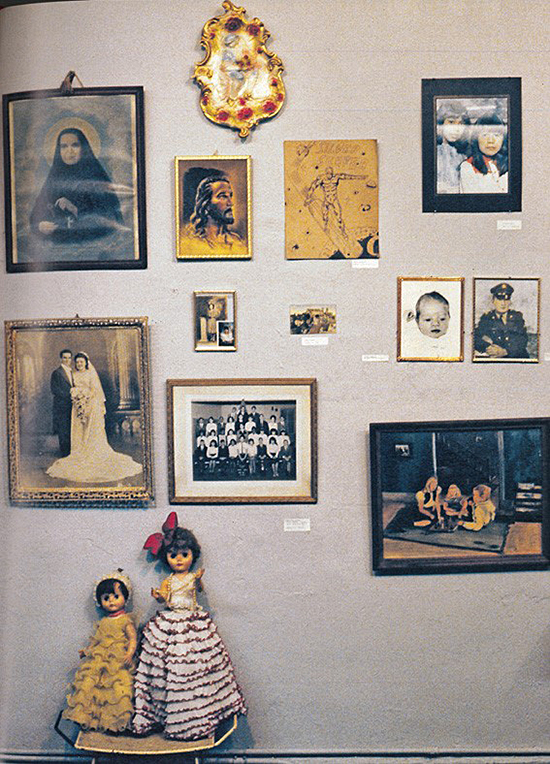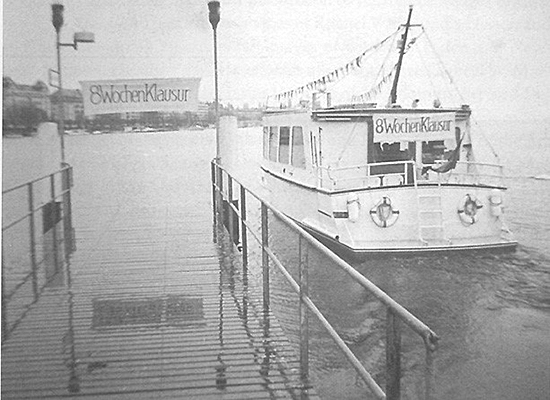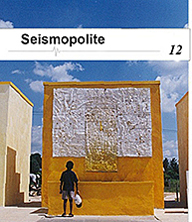October 8, 2015
The People’s Choice – Floating Dialogues. How artists create publics through conversation formats
Written by Fiona Geuss
When reading about or discussing artistic work that is actively concerned with social issues one often encounters expressions that artists seek "to show how the complexity of social problems can be investigated through artistic means“.[1] But what actually constitutes "artistic means“? Rather than videos, collages, installations or performances, what I am interested in are formats of conversation that are an intrinsic part of the artistic process. I will first sketch out that idea briefly and then investigate the relation between social responsibility and art by introducing two examples: Group Material’s early show "The People’s Choice (Arroz con Mango)" in their exhibition space in New York, 1981, and the "Floating Dialogues" by the Austrian Group WochenKlausur at the Shedhalle Zurich in 1994. I propose in these examples that social responsibility is less a concrete outcome, a measurable "improvement" of a certain social issue, than an improvement in the sense that it realizes Hannah Arendt’s notion of the political public as speaking and acting together.
Artists such as Group Material and WochenKlausur use art traditionally as a contemplative space in society, in order to activate the public outside of its common institutionalized forms. Arendt’s term of the "political public“, articulated in her book The Human Condition (1958) points to plurality and the human being together, as that space between, that emerges out of speaking and acting, out of "the sharing of words and deeds."[2] Speaking and acting are procedures, which do not leave concrete results or final products. But in their intangibility, they are not less real - or meaningful as I would say - than the world of objects in our visible surroundings.[3]
And I would argue that the social responsibility of the artistic practices I am talking about today lies in this interstice described by Arendt.
In the course of the nineteen-sixties artists increasingly embraced dialogue – with museums, gallery owners, art schools and their non-institutionalized recipients, the audience – as a central element of their artistic practice in order to engage with social and political concerns. This happened initially on an organizational level with the Art Workers Coalition founded in New York in 1969. These dialogical encounters functioned to break open and trouble the alignment of contemporary art with consumer culture and introduced current social and political issues in the institutional art context. This approach is continued in documentation based art practices of the 1970s. British artist Stephen Willats for example worked with inhabitants of social housing complexes to produce collages based on conversations. As U.S. based art historian Grant Kester most notably argued, in the second half of the 20th century conversation became part of an artistic practice that is not constructed in the studio, but instead seeks dialogue outside of it.[4]
Group Material was initiated by a group of young artists, mainly former students of Joseph Kosuth at the School of Visual Arts in New York in 1979. The group had the desire to set their own terms of producing and distributing their art works.
It was 1978 and we had no choice. We had to do something. We wanted to make a scene. A brilliant desperation was in the air for we young artists who wanted - needed - to be politically engaged but lacked any venues for new and true artistic inquiry, experimentation, demonstration, and change.[5]
This is how founding member Tim Rollins describes the atmosphere at the time when Group Material started to meet. A few months later in 1980 they opened a store front gallery in the Lower East Side. Instead of running an isolated white cube, Group Material understood their exhibitions as an interface between art and the neighborhood’s communities.[6] After running the gallery space for about one year the group split up and continued to work with a reduced number of members around Julie Ault until 1996.
“The People’s Choice,” later subtitled "Arroz con Mango“ (What a mess) was one of the first exhibitions in the Lower Eastside space. For the show Group Material invited the neighbors to contribute artifacts. On December 22, 1980 the group’s members went from door to door asking the residents for a meaningful object - family photographs, figures or religious images - from their home. Later each object and its lender was identified in the exhibition.[7]

This visualization of the community makes the exhibition different from ready-made installations in which the artist elevates the anonymous object into the sphere of art.[8] The wall text instead manifests participatory process and dialogue. As Allen Moore mentions in his publication on protest and counterculture in New York City, "The People’s choice“ was the "direct outcome of Group Material’s search for 'discourse’“.[9]
Tim Rollins described, retrospectively, the "collective conversation“ as Group Material’s artistic practice.[10]
By understanding the exhibition as potential discursive situation and creating a collaborative structure, Group Material proposed a notion of public that differed from the standard curatorial process of exhibition making. The press release describes it as follows: "A display of the private gone public, of the not-normally-found-in-an-art-gallery, of personal choice and cultural value on one block in New York City."[11]
But the residents did not take over the exhibition space to join and proceed with a broader cultural activism.[12] In the end, a closer collaboration between the group and the street’s residents failed. Group Material acknowledged the difficulties on the flyer "Caution! Alternative Space!" from September 1981 that announced the closure of the storefront space:
We’ve learned that the notion of alternative space isn't only politically phony and aesthetically naive - it can also be diabolical. It is impossible to create a radical and innovative art if this work is anchored in one special gallery location. Art can have the most political content and right-on form, but the stuff just hangs there silent unless its means of distribution make political sense as well.[13]
Nevertheless in "The People’s Choice" Group Material merges two different models of social space: that of the gallery and the neighborhood.[14] By generating this connecting line between art and society through conversation formats - namely, reaching out for the residents and offering the gallery space as a space for conversation - the artists created a different notion of "the public." This reflected on the status of society and one’s own position in and towards it, without necessarily focusing on a concrete outcome towards a certain issue, such as a disadvantaged neighborhood.
While conversation in "The People’s Choice" is mainly a structural device for the initiation of the project, understanding the exhibition as a potential discursive situation as Julie Ault did, is crucial for the practice of Group Material.[15] The next example offers a much clearer conversational scenario. In 1994 the Shedhalle Zurich invited the Austrian group WochenKlausur to work on an intervention into the drug problem of the cities.[16]
At that time the museum reoriented its entire program towards socially engaged art practices. WochenKlausur has been conducting interventions for art institutions since the early 90s. For each intervention the group uses the institution’s infrastructure and resources, from time to time turning the exhibition space into their studio. The group decided to establish an emergency accommodation for drug addicted prostitutes in Zurich, which is open not at nights but during the days when the prostitutes are not working.[17]
Similar efforts failed since the end of the 80s several times due to lacking support of residents and an ongoing negative coverage in local media.[18]
WochenKlausur finally managed to find an owner who agreed to rent his building to the initiative despite all protest of the neighborhood residents.

The group still had to look for political and medial support to finance the project on a long term basis. To do so WochenKlausur invited politicians, journalists, and drug addicts to have conversations on a boat in the Zurich lake, the "Floating Dialogues".[19] 15 conversations with 4 participants per session took place while the artists stayed at the dock to inform the passengers about the project. The group did not decide to stage a large press conference, or high profile expert symposium at the museum. They initiated 15 specific situations each with different protagonists, under varying circumstances, without documentation or a large audience. The lack of documentation is relevant in so far as it seems that the artists were not so much interested in what actually took place on the boat but how the conversations could lead to subsequent developments. Would a journalist think about discussing a different point of view on the issue with her colleagues? Would a politician talk about the topic in a different way when back in her everyday business?
Of course, one should not be naive about the exchanges that happened on the boat or take it too literally. In a newspaper published by the Shedhalle in 2005 one of the Shedhalle curators who participated describes how the talks were nice, but did not give any reason to assume that the politicians would change their existing opinion regarding the topic.[20] But, another aspect of the "Floating Dialogues" is also to face assumptions one has towards social groups or specific social roles.
Crucial for this examination is that the boats with the invited participants generated a public, which was not a defined group of exhibition visitor or drug addict. They withdrew from traditional modes of representation, by simply leaving the dock. With the "Floating Dialogues" WochenKlausur created a site for exchange, which otherwise would have been impossible in existing social and political configurations. This work questioned existing structures and roles in society in order to re-examine them.
A conversation is a far too complex situation to be analyzed in the context of this short paper especially due to the limits to document its entire context. What can be said is that Group Material as well as WochenKlausur elicit and question assumed structures within social settings. By introducing ideas of what is meant by the public and who comprises that public, both examples exceed the demonstrative character of participatory art practices, which often assume their “public“ as unproblematic, instead of carefully creating it.
Group Material brings together two separate social sites - the gallery and the neighborhood. Not as a community display, but by collectively shaping the space in which the communal action, the exhibition, takes place. WochenKlausur, too, creates a site that did not exist before. With a social setting of participants coming from different contexts, that potentially would not have intersected outside of this art project. In both cases forms of conversation are the starting point and outcome of what happened (meeting the residents, being in the exhibition, researching and meeting protagonists, being on the boat) - rather than being only a means to an end, as stated at the beginning, conversation constitutes an artistic practice.
I would like to understand those sites produced in the described artistic works as Arendt’s space between. A space in which people not only speak but also act together, a space in which the "sharing of words and deeds" is possible.[21] In their book "Public sphere and experience" from 1972, Alexander Kluge and Oskar Negt describe how the bourgeois public tends to separate speaking and acting and with it political impulse from its realization.[22]
They understand "the public" as an oppositional force. Without leading to final results or visible products the procedures of acting and speaking create something more meaningful: communal experience, exchange and shared action. In short, a notion of public outside of its common institutionalized forms. Pointing to the possibility that those sites can and do exist is what constitutes the social responsibility of the described artistic practices.
Fiona Geuß (born 1981) is an art historian and Phd candidate at the Freie Universität in Berlin. Her research topic concerns the dialogical artwork and forms of conversation in artistic practices since the 1970s. She was managing editor of the catalogue „Perform a Lecture!“ (2011) and co-organizer of the event space “Salon Populaire“ in Berlin Schöneberg (2010–2012). Since 2010 she organizes seminars at the “The Public School Berlin“, an autodidactic, pedagogical framework. Geuß held lectures and participated in conferences, amongst others “Forms/models of education and self- determination“ at NGBK Berlin, “Education Engineering Days“ in Helsinki and “When exhibitions become politics“ at the Friedrich Schiller Universität in Jena. In 2014 Geuß was Visiting Curator at Gertrude Contemporary in Melbourne. Geuß is co-founder of the Berlin-based initiative “A Public Library”.
[1] Jan Avgikos, Group Material Timeline: Activism as a Work of Art, in: Nina Felshin, But is it Art? The spirit of Art as activism, Seattle 1995, p. 88.
[2] Arendt, The Human Condition, Chicago/London 1969, p. 198.
[3] Ibid., p. 182-183.
[4] Grant Kester, Conversation pieces: community and communication in modern art, Berkeley 2004.
[5] Tim Rollins, What Was to be Done?, in: Julie Ault (ed.), Show and Tell: A Chronicle of Group Material, London 2010, p. 217.
[6] Avgikos 1995, p. 92.
[7] Image source: Julie Ault (ed.), Show and Tell: A Chronicle of Group Material, London 2010, p. 33.
[8] Alison Green, Citizen Artists: Group Material, in: Afterall Journal, Vol. 26, spring 2011, p. 18.
[9] Alan W. Moore, Art Gangs. Protest and Counter Culture in New York City, New York 2011, p. 115.
[10] Rollins 2010, p. 218.
[11] Julie Ault (ed.), Show and Tell: A Chronicle of Group Material, London 2010, p. 34.
[12] Avgikos 1995, p. 98.
[13] Ibid., S. 99.
[14] Ibid., S. 92.
[15] Moore 2011, p. 113.
[16] Wolfgang Zinggl, Intervention zur Drogenproblematik, in: Wolfgang Zinggl (ed.), WochenKlausur. Gesellschaftspolitischer Aktivismus in der Kunst, Wien 2001, p. 28-35.
[17] Ibid., p. 31.
[18] Ibid.
[19] Image source: Grant Kester, Conversation pieces: community and communication in modern art, Berkeley 2004, p. 2.
[20] Statement by Sylvia Kafehsy, in: Shedhalle Zeitung, April 2005, p. 18-19, http://archiv.shedhalle.ch/dt/programm/zeitung/05/inhalt/shed_zeitschrift_April05.pdf, as of July 28, 2015.
[21] Arendt 1969, p. 198.
[22] Oskar Negt/Alexander Kluge, Öffentlichkeit und Erfahrung, Frankfurt am Main 1972, p. 94.









